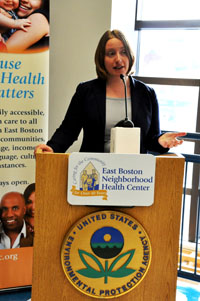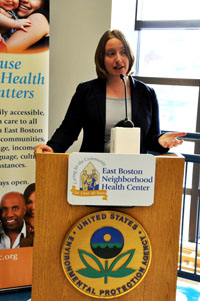
 Americans have long known the dangers of mercury in our environment, with doctors repeatedly warning pregnant women to remove fish from their daily diets. But despite this solid knowledge of the health impacts, the United States has never regulated mercury emissions from powerplants — our nation’s number one source of mercury — until now.
Americans have long known the dangers of mercury in our environment, with doctors repeatedly warning pregnant women to remove fish from their daily diets. But despite this solid knowledge of the health impacts, the United States has never regulated mercury emissions from powerplants — our nation’s number one source of mercury — until now.
Last month, the Environmental Protection Agency (EPA) issued Mercury and Air Toxics Standards. The standards require coal-fired powerplants to install scrubbing technology that will cut 90 percent of their mercury emissions by 2015.
To better inform local residents about the new protections, Noelle Eckley Selin— an assistant professor in MIT's Engineering Systems Division and Department of Earth, Atmospheric and Planetary Sciences and a researcher in MIT’s Joint Program on Global Change — this week joined EPA Regional Administrator Curt Spalding and other public health experts at a public availability session at the East Boston Neighborhood Health Center.
“These mercury standards help prevent the developmental delays and neurological damages that could come from eating contaminated fish,” Selin said at the Thursday event.
At MIT, Selin looks at the pathways by which mercury reaches the environment and the effect it has on human health once it gets there. She also analyzes the steps regulators could take — and in some cases have taken — to prevent further contamination.
“There’ve been proposals for a long time to regulate these emissions from coal-fired powerplants,” Selin said in an interview with the Los Angeles Times when the rules were first released on Dec. 21, 2011. “The earlier incarnation of this was the Clean Air Mercury Rule, which was a cap-and-trade proposal for mercury, and that was challenged in the courts and then thrown out. And now this is another try at regulating, but it’s been a long time in coming.”
Massachusetts began controlling mercury in the 1990s. Since then, the state has reduced mercury emissions by 91 percent, according to Massachusetts Department of Environmental Protection Commissioner Kenneth Kimmell.
“It has been a major source of frustration for us that even though we’ve reduced our mercury rates by so much, many of our water bodies are still off limits to fishing because of pollution from upwind states,” Kimmell said at the Thursday event.

Massachusetts’s experience shows that tough standards can have a substantial effect on the environment, Selin said. But federal regulations such as the Mercury and Air Toxics Standards are necessary because of the pollution that comes from powerplants in coal mining and producing states.
Health benefits
Rachel Murphy of Cambridge has a 6-year-old daughter with severe asthma. Her daughter’s asthma is so bad that at times she coughs hard enough to burst blood vessels in her eyes.
“Rachel can get the best medicine possible, but she can’t control the air her daughter breathes,” New England’s American Lung Association President Jeffrey Seyler said at the event.
The air toxics standards are expected to help tens of thousands of children such as Murphy’s daughter by preventing 30,000 cases of childhood asthma symptoms and about 6,300 fewer cases of acute bronchitis among children each year, according to EPA estimates.
Vulnerable populations such as infants will also be helped specifically because of the mercury standards under the new rule.
“These will especially protect newborns who are at a greater risk during their development,” Selin said. “It’s estimated more than 300,000 newborns in the U.S. are exposed in utero to dangerous levels of mercury. This can cause lower IQ and neurological damages.”
Dr. Alan Woolf, the director of the Pediatric Environmental Health Center at Children's Hospital in Boston, agrees.
“Mercury is associated with long-lasting and potentially irreversible effects on the brain and nervous system,” Woolf said at the event. “These effects can reduce a child’s intelligence, can change their behavior, and can cause seizures, muscle weakness, paralyses and other neurologic injuries limiting their future as productive citizens.”
International implications
The United States’s leadership in regulating mercury comes at an important time, as countries around the world have been negotiating a global, legally binding mercury treaty since June 2010.
The third of five planned United Nations negotiating sessions occurred in November in Nairobi, Kenya, and Selin plans to attend the fourth in June in Uruguay. She will also be bringing six graduate students, as part of a National Science Foundation grant, to the final negotiating session set to take place in early 2013.
In an earlier interview with MIT News, Selin said domestic politics would likely continue to be a challenge for U.S. implementation of environmental regulations and international cooperation on mercury. But with these standards — now the most stringent mercury standards of its kind in the world — she says the country has proven their leadership.
“These standards show that the U.S. is taking leadership at home to address a widespread and substantial global problem.”

From Left to Right - Manny Lopes, Deputy CEO East Boston Neighborhood Health Center, Jeffrey E. Seyler, President and Chief Executive Officer, American Lung Association, New England, Dr. Alan Woolf, Director, Pediatric Environmental Health Center, Children's Hospital, Boston, Dr. Noelle Eckley Selin, Assistant Professor, Engineering Systems Division and Dept. of Earth, Atmospheric and Planetary Sciences at MIT, Kenneth Kimmell, Commissioner, Massachusetts Department of Environmental Protection, Curt Spalding, Regional Administrator, EPA New England, Jim Hunt, City of Boston Environmental and Energy Services

